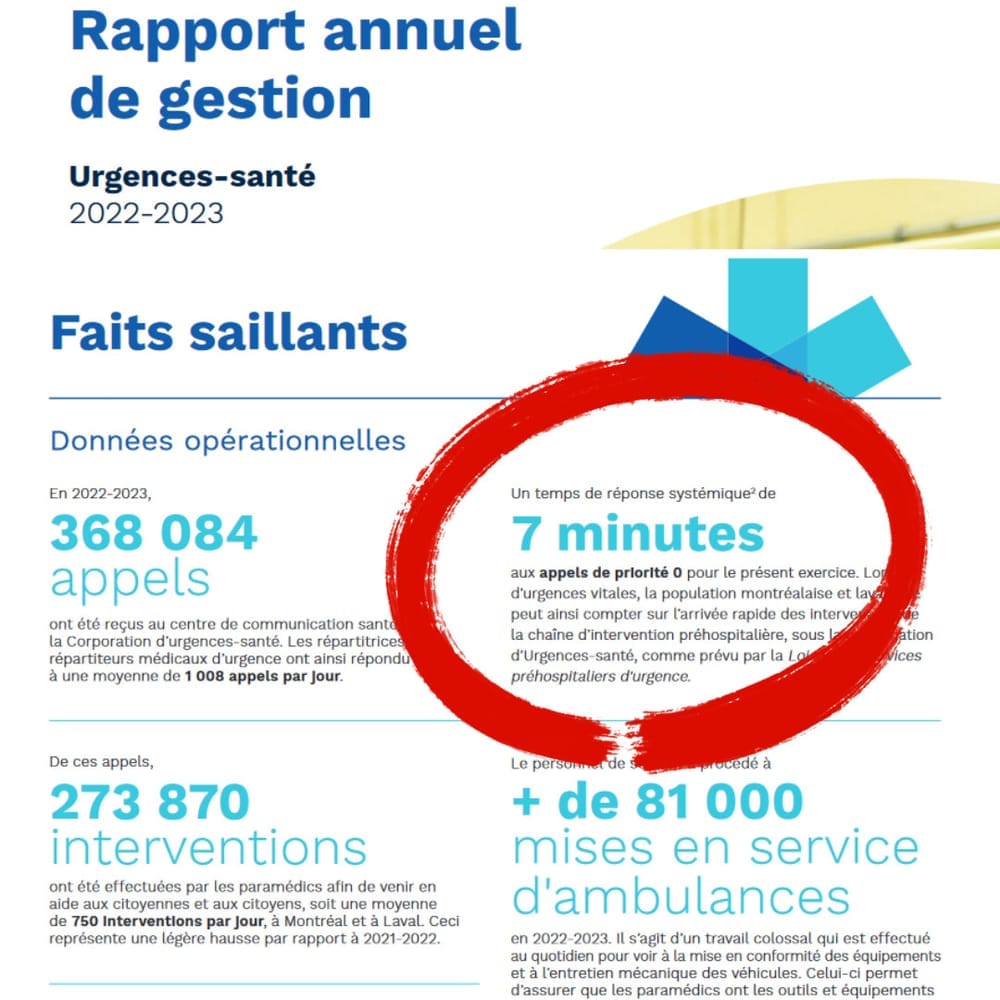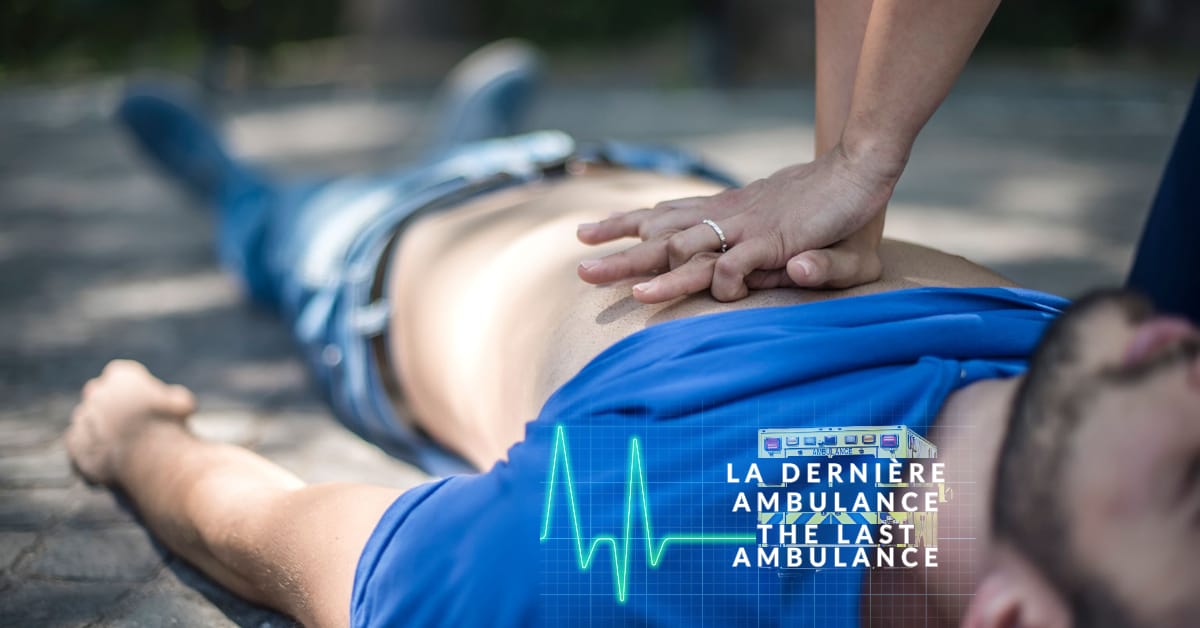Nine minutes

with data analysis by Mike Baranchuk
After a prolonged Access to information request process, The Last Ambulance obtained all response time data for tens of thousands of calls to which Urgences-santé responded from November 23, 2023, to March 12, 2024. This is the second in a series of articles based on that data.
One of the public's fundamental expectations of an emergency service provider is quick arrival when needed. This is especially critical for life-threatening medical emergencies, where survival chances are linked to the response time of trained emergency medical responders.
Response time is a key performance indicator for emergency prehospital care providers (EMS) and the overall emergency medical system. Unfortunately, there is a lot of confusion and misunderstanding about the different ways response performance is reported.
For the patient, the clock starts from the beginning of the critical medical condition. In this discussion, we address patients in cardiac or respiratory arrest and those with an imminent life-threatening condition that could evolve into an arrest at any time.
In the classification system, a patient deemed at high risk of cardio-respiratory arrest is classified as Priority 0 (zero), and a critical patient is Priority 1. Both classifications require the fastest possible response because the critical patient could go into cardiac arrest at any moment.
How fast is fast enough when it comes to a condition where the patient's survival chances decrease with each passing minute? Time is absolutely crucial in these cases.
The most commonly accepted response time standard for major EMS providers in urban areas of North America is 8 minutes and 59 seconds. A response time of 8 minutes and 59 seconds or less is considered meeting the standard. Any response of 9 minutes or more is considered a failure to meet the standard.
During this time, a 9-1-1 call is expected to be answered and redirected to the emergency health communications center, the call triaged, and the nearest available unit(s) with the appropriate capabilities dispatched. The response time clock stops when responders reach the patient.
The accepted performance level for most major EMS providers is that the response time target will be met in 90% of responses. This means that 9 times out of 10, the response unit should reach the patient in less than 9 minutes. This is a very demanding standard and requires a very efficient system with the appropriate resources to achieve it; however, this is what we must expect from a system meant to save lives. It is one of the very few public services where your life can literally depend on it.
In Montreal and Laval, Urgences-santé is the primary EMS provider. We have heard many times that the service meets expectations because the average response time is slightly below 9 minutes. This sounds very reassuring until we examine what it really means.
If we think of an average response time, without going into precise statistical definitions, we would expect that about half of the responses are under the target time and that about half are probably over the target time. The question we should really ask is what percentage of calls meet the target and what percentage take longer.
When the data is properly analyzed, we can see that the response time target is not even met 50% of the time in most areas served by Urgences-santé. Suddenly, the assurances that everything is working well need to be questioned.
The following table, based on data extracted from the Urgences-santé record-keeping system, indicates the percentages of responses that meet the target of less than 9 minutes.
These figures tell us that in downtown Montreal (Sector 5), an ambulance arrives in less than 9 minutes 59% of the time for the highest priority calls, but in the West Island (Sector 4), the target is met only 37% of the time.
For Priority 1 calls, considered life-threatening, the corresponding figures are 42% downtown and 23% in the West Island. It is evident that the actual performance level is well below the 90% target in every sector.
The next logical question might be to ask how long response times correspond to a 90% performance level. The figures indicate the response times that correspond to a 90% performance level. This means that the response time for one out of ten calls exceeds the time indicated.
It is evident that response time performance is the weakest in the West Island, where 10% of Priority 0 responses take 19 minutes or more and 10% of Priority 1 responses take 22 minutes or more.
Impact of First Responders
Throughout the Montreal agglomeration and more recently in Laval, fire services and Côte Saint-Luc EMS provide first responder services. This means a vehicle with trained first responders is dispatched to all Priority 0 calls and some Priority 1 calls, with the expectation that they will arrive faster than an Urgences-santé ambulance.
This service saves lives every week because the response times are consistently faster, and first responders can provide the first level of care to patients.
This leads us to the statement published in the 2022-2023 annual report of Urgences-santé.

It is interesting to note that Urgences-santé boasts about the performance of first responders in its annual report, without specifically crediting them.
In Montreal, fire service first responder units have a response time target of 6 minutes and 24 seconds, and this standard is met more than 80% of the time. If first responder response times are evaluated against the standard of less than 9 minutes, performance levels are consistently between 91% and 97%.
This relieves much of the pressure on Urgences-santé to meet their response time targets. The ambulance can take longer to arrive because the firefighters are on site and taking care of the patient, but the capabilities of first responders are limited, apparently by design of the Quebec system.
There are serious systemic issues contributing to Urgences-santé's response time problems (with a $180M budget in 2023), starting with a shortage of resources and a constantly increasing demand for service. Additionally, overcrowding in many hospital emergency departments means paramedic teams often spend long periods caring for patients after arriving at the hospital, as hospital staff are unable to take over the patients. The result is that ambulances are held up at the hospital instead of getting back on the road to be ready for the next call.
First responders, who are essential in providing initial care to patients in a reasonable timeframe, often end up waiting several minutes for an ambulance to arrive. In the meantime, they can only provide the level of treatment authorized for first responders.
Given the importance of first responders in this situation, it is difficult to understand why there are proposals at the ministerial level in Quebec to reduce the first responder service in Montreal.
The proposal aims to lower training requirements for first responders in Montreal and significantly reduce the type of calls they are dispatched to. This is part of a master plan to encourage many small communities in Quebec to start providing a first responder service. Strategists believe that the existing first responder service in Montreal should be leveled down to match the expectations of small communities that do not currently provide this service.
Rather than investing the necessary money to ensure that first responders—who could include paramedics if the government could think outside the Quebec framework and adopt practices from several major North American cities—the MSSS seems content to roll the dice and hope that you won't need paramedic-level care within 9 minutes.
This is the second in a series focused on the performance of Quebec's largest ambulance service: Urgences-santé.
We published the first earlier this week. There are more to come.

You can support The Last Ambulance by purchasing a paid subscription. Being the only independent press publisher covering the emergency prehospital care system in Quebec doesn't come cheap, and your support helps us focus on journalism.



